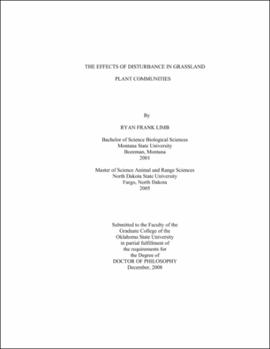| dc.contributor.advisor | Bidwell, Terrence G. | |
| dc.contributor.author | Limb, Ryan Frank | |
| dc.date.accessioned | 2013-11-26T08:26:09Z | |
| dc.date.available | 2013-11-26T08:26:09Z | |
| dc.date.issued | 2008-12 | |
| dc.identifier.uri | https://hdl.handle.net/11244/6846 | |
| dc.description.abstract | Scope and Method of Study: We examined vegetation dynamics and livestock grazing in response to stress and disturbance on rangelands in two different studies, one in north central Oklahoma and one in central Kansas. The study in north central Oklahoma measured the herbaceous plant community response to stress along a gradient of increasing eastern red cedar (Juniperus virginiana) canopy cover in tallgrass prairie. The study in central Kansas investigated the plant community and livestock grazing response to anthropogenic disturbance in native mixed grass prairie. | |
| dc.description.abstract | Findings and Conclusions: In the north central Oklahoma study, plant species richness declined with increased eastern red cedar canopy cover. However, the rate of decline in species richness closely followed that which was predicted by a species-area relationship. Furthermore, the decline was uniform among C3, C4 and forb species groups. Annual herbaceous above-ground production declined with increasing eastern red cedar canopy cover, but was most variable at intermediate canopy cover. These results indicate that eastern red cedar reduces species richness. However, canopy cover up to 80% does not impose an ecological threshold. In the central Kansas study, we used tracked vehicles to impose anthropogenic focal soil disturbance within a mixed-grass landscape extensively disturbed with livestock grazing or hay harvest. In both landscapes focal soil disturbance had a larger influence on plant community composition than either livestock grazing or hay harvest. Moreover, combined focal and extensive disturbance did not have a greater effect than focal disturbance alone. Despite differences in initial plant species composition, successional trajectories following focal soil disturbance were similar between grazed and hayed communities, and both plant communities recovered from focal soil disturbance within two growing seasons. Tracked vehicle disturbance attracted preferential livestock grazing, which promoted structural heterogeneity within the plant community. However, the effect was ephemeral and only lasted one growing season. | |
| dc.format | application/pdf | |
| dc.language | en_US | |
| dc.rights | Copyright is held by the author who has granted the Oklahoma State University Library the non-exclusive right to share this material in its institutional repository. Contact Digital Library Services at lib-dls@okstate.edu or 405-744-9161 for the permission policy on the use, reproduction or distribution of this material. | |
| dc.title | Effects of disturbance in grassland plant communities | |
| dc.contributor.committeeMember | Engle, David M. | |
| dc.contributor.committeeMember | Fuhlendorf, Samuel D. | |
| dc.contributor.committeeMember | Hickman, Karen R. | |
| osu.filename | Limb_okstate_0664D_10036.pdf | |
| osu.accesstype | Open Access | |
| dc.type.genre | Dissertation | |
| dc.type.material | Text | |
| dc.subject.keywords | grazing | |
| dc.subject.keywords | hay harvest | |
| dc.subject.keywords | soil disturbance | |
| dc.subject.keywords | visual obstruction | |
| dc.subject.keywords | woody encroachment | |
| thesis.degree.discipline | Natural Resource Ecology and Management | |
| thesis.degree.grantor | Oklahoma State University | |
